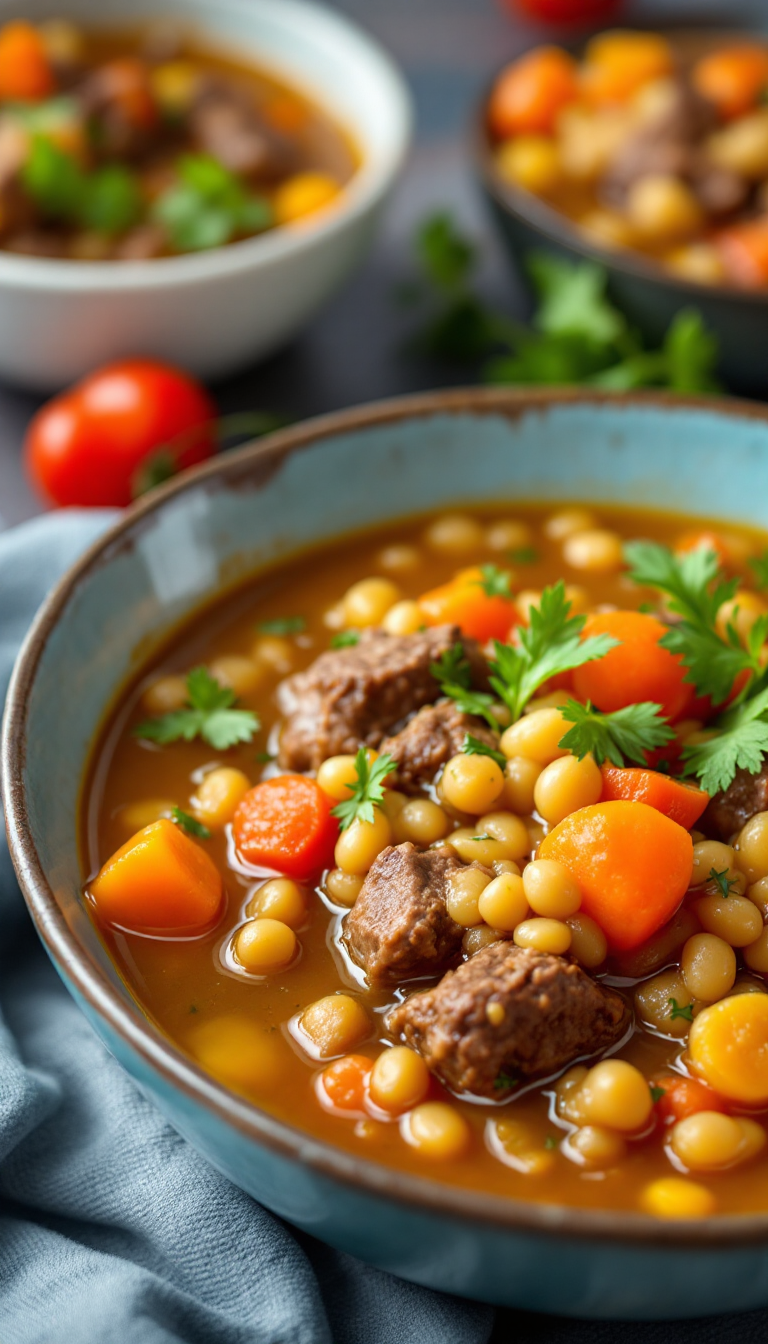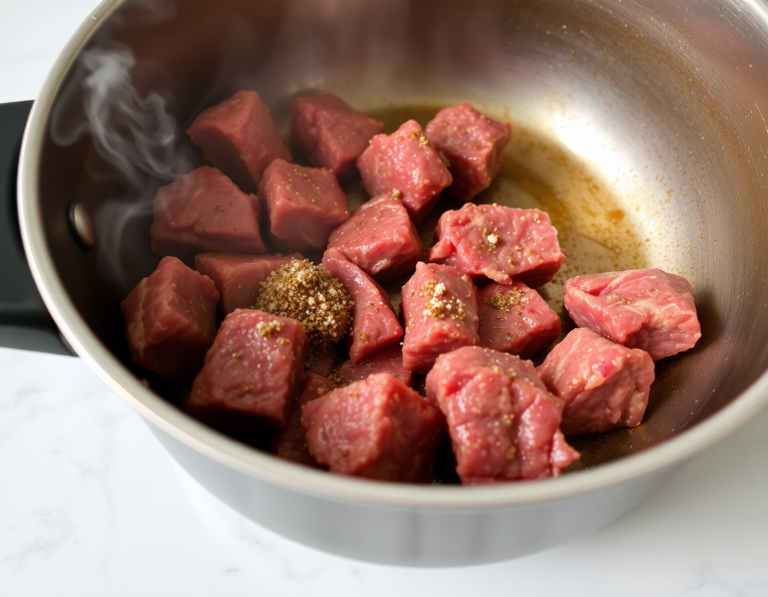
Can you smell that? It’s the aroma of beef barley soup simmering on the stove—it’s like a warm hug on a chilly night. I stumbled upon this gem after a long day at work, craving something hearty yet simple, and boy, did it deliver. Rich, savory, and somehow nostalgic, it’s the kind of soup that makes you want to curl up with a blanket and forget the world outside.
Steps
- Season the beef with salt and pepper. In a large pot or Dutch oven, heat oil over high heat until it starts to smoke slightly. Add the beef in batches if needed, and cook until well browned on all sides, about 5 minutes per side. Transfer the browned beef to a large platter.
- Add the diced carrots, onion, celery, and chopped garlic to the pot. Cook while stirring and scraping up any browned bits from the bottom until the vegetables are lightly browned, about 6 minutes. Remove the vegetables to a heatproof bowl and set aside.
- Pour the stock into the pot and return it to heat, ensuring to scrape up any remaining browned bits from the bottom. Meanwhile, cut the beef into smaller chunks, then add to the pot along with the reserved bones and the herb sachet. Bring the mixture to a simmer, then reduce the heat and cook gently until the beef is tender, about 1 to 2 hours, skimming off any foam that forms on the surface.
- Remove and discard the bones and herb sachet. Add the barley, sautéed vegetables, and fish sauce if using, and simmer until the barley and vegetables are tender, about 30 minutes. Adjust the seasoning with salt and pepper, and add water if the soup is too thick. Serve hot, garnishing with minced fresh parsley.

Ingredients
- 2 pounds (1 kg) boneless beef chuck roast, cut into 1 1/2-inch steaks, or 3 pounds (1.3 kg) bone-in beef short ribs, with ribs removed and reserved
- Kosher salt, to taste
- Freshly ground black pepper, to taste
- 1 tablespoon (15 ml) canola oil
- 3 large carrots (10 ounces; 280 g), diced
- 1 large yellow onion (12 ounces; 340 g), diced
- 2 ribs of celery (6 ounces; 170 g)
- 4 medium cloves of garlic, roughly chopped
- 3 quarts (3 L) homemade or store-bought chicken stock
- Sachet containing 2 sprigs of fresh thyme, 1 bay leaf, and approximately 5 whole black peppercorns
- 1 cup pearled barley (7 ounces; 200 g)
- 1/2 teaspoon (3 ml) Asian fish sauce (optional)
- Minced fresh parsley, for garnish
FAQ
- What type of beef is best for beef barley soup?
- For beef barley soup, it is recommended to use collagen-rich cuts such as chuck roast or short ribs. These cuts become tender with slow cooking and add a rich flavor to the soup.
- Why should I use chicken stock instead of beef stock in beef barley soup?
- While real beef stock can be used, chicken stock is often recommended because store-bought beef stock tends to have poor flavor. Chicken stock provides a neutral base that allows the beef’s flavors to shine through after simmering.
- How can I enhance the flavor of the soup broth?
- To enrich the broth, add aromatics like fresh thyme, a bay leaf, and peppercorns. Additionally, a small amount of fish sauce can deepen the umami flavor without adding fishiness.
- What is the benefit of browning the beef in large pieces?
- Browning large pieces of beef helps develop a deep, roasted flavor without drying out the meat. This ensures the beef remains juicy and tender in the soup.
- How should I store leftover beef barley soup?
- Beef barley soup freezes well and can be stored in the freezer for three to six months. This makes it convenient for future meals.
Tips
- Select the Right Beef Cut: Opt for collagen-rich cuts like chuck roast or short ribs. These cuts become tender and infuse the soup with rich flavor during slow cooking, as their collagen breaks down into gelatin.
- Brown the Meat in Large Pieces: Browning larger pieces of beef before cutting them into smaller chunks helps develop deep, roasted flavors without drying out the meat. This method ensures a juicy and tender beef texture in your soup.
- Use Chicken Stock for Better Flavor: If you don’t have homemade beef stock, use chicken stock instead. It provides a more neutral base that, when combined with beef, results in a flavorful broth, unlike store-bought beef stock, which often lacks depth.
- Add Vegetables Towards the End: Sauté your aromatic vegetables first and set them aside. Adding them back to the soup towards the end of cooking prevents them from becoming flavorless and mushy, allowing them to retain their character while enhancing the broth.
Equipment
- Dutch Oven or Large Pot – Essential for browning the meat and simmering the soup. A heavy-duty pot helps in maintaining even heat distribution.
- Filleting Knife – Useful if you choose to debone the short ribs yourself.
- Cheesecloth or Tea Ball – For making the herb sachet to easily remove herbs after cooking.